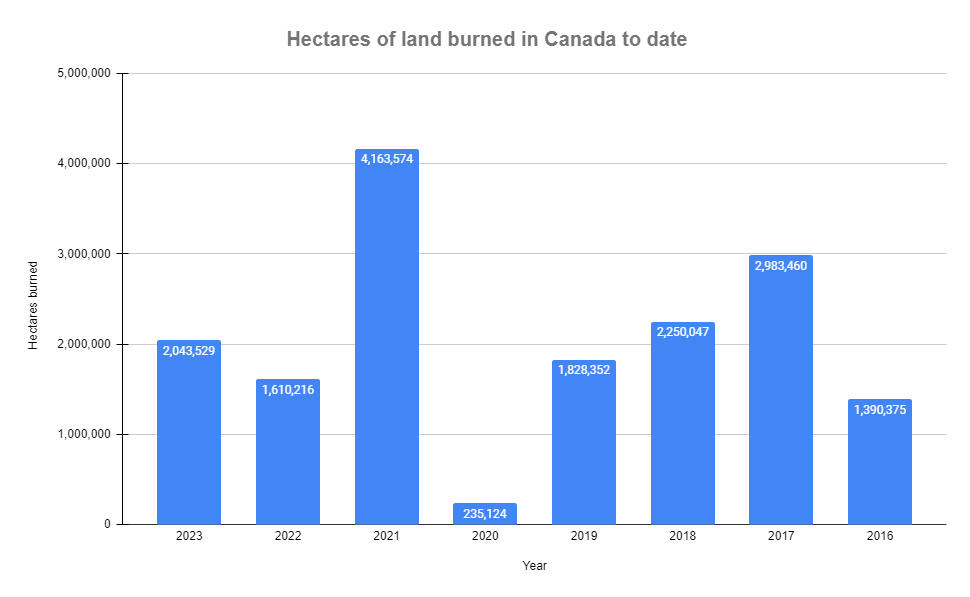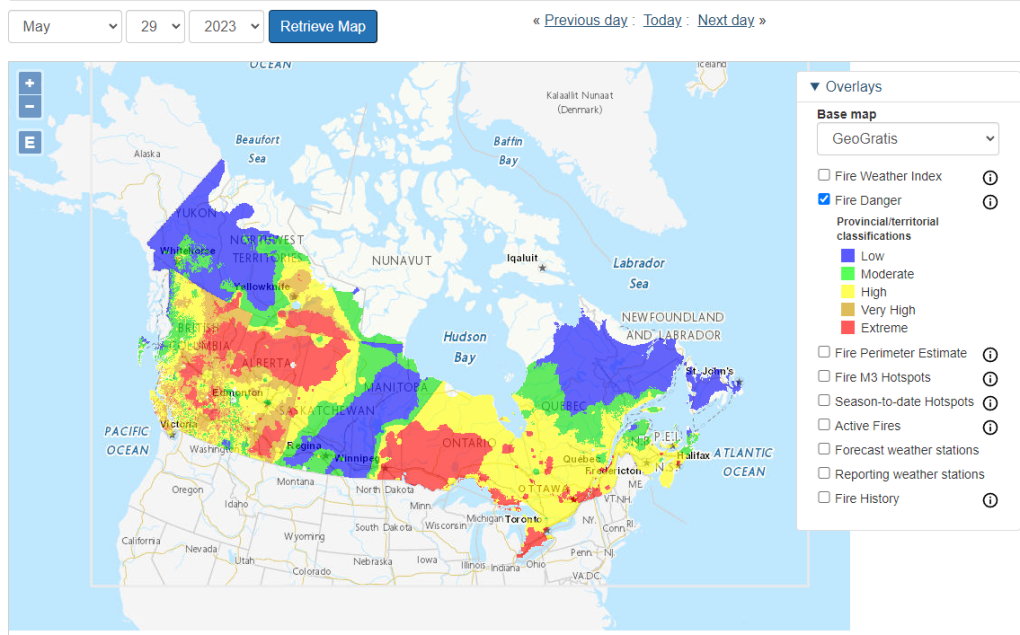
NEW After hearing thousands of last words, this hospital chaplain has advice for the living
Hospital chaplain J.S. Park opens up about death, grief and hearing thousands of last words, and shares his advice for the living.
Wildfires have burned more than2 million hectares of land across Canada so far this year, during what has been one of the earliest fire seasons on record.
According to the National Wildland Fire Situation Report, the fires in Yukon, B.C. Alberta, Northwest Territories, Saskatchewan and Manitoba are among the nearly 1,600 recorded so far this year.
Experts use the Canadian Forest Fire Danger Rating System to identify where in Canada people should take precautions.
"Forest fire danger is ageneral term used to express a variety of factors in the fire environment, such as ease of ignition and difficulty of control," the government's website reads.
Many parts of Canada are blanketed in red or yellow, indicating a high degree of fire risk, according to the Natural Resources of Canada interactive fire risk map.
 The above graph was made using data from current and archived reports from Natural Resources Canada. Data was available from May to November for some of the entries and May to October for others. (Natasha O'Neill/ CTVNews.ca)
The above graph was made using data from current and archived reports from Natural Resources Canada. Data was available from May to November for some of the entries and May to October for others. (Natasha O'Neill/ CTVNews.ca)
With dry and sunny weather across the country, the risk of new fires is spreading, including in Northern Ontario and in Nova Scotia, where some Halifax-area residents are among the evacuees due to anout-of-control fire burning near Upper Tantallon.
In Alberta, where a brief period of cool, wet weather brought temporary respite, conditions changed over the weekend and fires threatened northern communities.
Parts of the Prairies have a heightened fire risk, and there are other parts of Canada that have been labelled as having an "extreme" risk of forest fires.
The highest risk of wildfires is labelled as "extreme," a category that includes a fast-spreading, high-intensity fire that does not respond to suppression tactics from fire crews.
Portions of B.C., Alberta and northern Saskatchewan are under these conditions. Much of Northern Ontario and part of Southwestern Ontario are also under extreme wildfire warnings.
As of May 29, the risk of fires starting is lower in portions of Yukon, Northwest Territories, the area around Regina, most of Manitoba and northern Quebec, the Natural Resources of Canada map shows. This means any fires sparked are "likely to be self-extinguishing" and new ignitions are unlikely, the government website reads.
Despite some areas being labelled low-risk, in the Northwest Territories, for example, there are still out-of-control wildfires burning.
The term "moderate risk" describes areas where fire crews can "easily" contain fires with pumps of hand tools. These areas can often be seen as the buffer between low- and higher-risk forest fire areas. Currently, communities like Lac Mistassini and Lac Manouanis in northern Quebec have a moderate fire risk.
High-risk fire warnings are used in areas that would be difficult for crews to battle and where flames could spread quickly, such as in dense, old-growth forests. Large equipment would be needed, like bulldozers, tanker trucks and aircraft to transport water, to fight any fires that broke out.
As of May 29, communities in B.C., Alberta and most of Ontario are in the high-risk classification.
Area around Carnaby, Red Rose and Boulder City, B.C., are in this category, as well as communities outside of Edmonton including Drayton Valley, Barrhead and Fort Saskatchewan.
Communities in Ontario with a high risk of fires include Fort Albany, Timmins, Barrie and towards Lake Ontario in Oshawa and Belleville.
A separate "very high" risk classification is for areas with conditions beyond the abilities of ground crews, with needed air attacks of fire retardant. Communities around Calgary and in Yellowknife are in this category, with officials warning fires could spread out of control.
 The above map from Natural Resources Canada uses data from government agencies and may not show the current fire situation. (Screenshot)
The above map from Natural Resources Canada uses data from government agencies and may not show the current fire situation. (Screenshot)

Hospital chaplain J.S. Park opens up about death, grief and hearing thousands of last words, and shares his advice for the living.
More money will land in the pockets of some Canadian families on Friday for the latest Canada Child Benefit installment.
An apparent Israeli drone attack on Iran saw troops fire air defences at a major air base and a nuclear site early Friday morning near the central city of Isfahan, an assault coming in retaliation for Tehran's unprecedented drone-and-missile assault on the country.
American millionaire Jonathan Lehrer, one of two men charged in the killings of a Canadian couple in Dominica, has been denied bail.
Canadian banks that refuse to identify the carbon rebate by name when doing direct deposits are forcing the government to change the law to make them do it, says Environment Minister Steven Guilbeault.
A woman who recently moved to Canada from India was searching for a job when she got caught in an online job scam and lost $15,000.
Prince Harry, the son of King Charles III and fifth in line to the British throne, has formally confirmed he is now a U.S. resident.
Colin Jost, who co-anchors Saturday Night Live's 'Weekend Update,' revealed who he thinks is one of the best hosts on the show.
Nearly half of China's major cities are suffering 'moderate to severe' levels of subsidence, putting millions at risk of flooding especially as sea levels rise.

Kevin the cat has been reunited with his family after enduring a harrowing three-day ordeal while lost at Toronto Pearson International Airport earlier this week.
Molly Knight, a grade four student in Nova Scotia, noticed her school library did not have many books on female athletes, so she started her own book drive in hopes of changing that.
Almost 7,000 bars of pure gold were stolen from Pearson International Airport exactly one year ago during an elaborate heist, but so far only a tiny fraction of that stolen loot has been found.
When Les Robertson was walking home from the gym in North Vancouver's Lower Lonsdale neighbourhood three weeks ago, he did a double take. Standing near a burrow it had dug in a vacant lot near East 1st Street and St. Georges Avenue was a yellow-bellied marmot.
A moulting seal who was relocated after drawing daily crowds of onlookers in Greater Victoria has made a surprise return, after what officials described as an 'astonishing' six-day journey.
Just steps from Parliament Hill is a barber shop that for the last 100 years has catered to everyone from prime ministers to tourists.
A high score on a Foo Fighters pinball machine has Edmonton player Dave Formenti on a high.
A compound used to treat sour gas that's been linked to fertility issues in cattle has been found throughout groundwater in the Prairies, according to a new study.
While many people choose to keep their medical appointments private, four longtime friends decided to undergo vasectomies as a group in B.C.'s Lower Mainland.